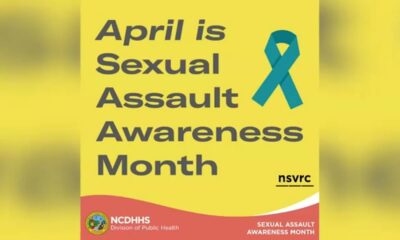News from the South - North Carolina News Feed
‘Beyond grateful:’ Unprecedented donations pour in from every state following Helene • Asheville Watchdog
Money has been pouring into western North Carolina in unprecedented amounts since Tropical Storm Helene from individual donors, corporations and foundations throughout the U.S.
At least $205 million has been raised or made available through disaster relief funds, benefit concerts and fundraisers, Asheville Watchdog found. Nonprofits in the region have raised millions more to provide food, housing and grants to storm victims and businesses.
Dogwood Health Trust, created with proceeds from the sale of Mission Health in 2019, has contributed the most. Dogwood announced a third round of Helene relief funding Thursday, bringing its commitment to $70 million.
Individual and corporate donations have come in through traditional means, such as contributions to foundations and agencies assisting in the recovery, but also through direct appeals to the public on crowdfunding platforms. GoFundMe campaigns started by individuals, businesses and artists in North Carolina have raised more than $40 million, nearly half of that going to fundraisers in Buncombe County, a company spokesman said.
“The outpouring from across North Carolina, across the country, has been overwhelming and also just unprecedented in terms of past disasters,” said Jennifer Tolle Whiteside, president and CEO of the North Carolina Community Foundation in Raleigh.
The foundation’s Disaster Relief Fund for long-term recovery has raised $12 million, already doubling the amount collected after the last hurricane, Florence, in 2018, she said.
“We are beyond grateful for the incredible outpouring of support that we’ve received,” said Mary Nesbitt, chief development officer of MANNA FoodBank, which lost two warehouses and all contents in Helene. “In the midst of a catastrophe of this magnitude, it has been so inspiring to see the goodness of humanity and all the ways that people have reached out to try to help.”
But even as some nonprofits set fundraising records, many fear it won’t be enough. They worry that disaster donations could jeopardize end-of-the-year giving that so many rely on for annual operations and that the generosity could dry up as attention on the storm fades.
“There’s this real reality of potential donor fatigue,” said Jessie Figueroa, resource development director for Homeward Bound of WNC. “Even the donors that we normally can rely on to contribute towards that end of year campaign, did they already give elsewhere in the community and kind of exhaust their philanthropy budget?”
Donations from every state
Charitable giving typically ramps up after a natural disaster, particularly in the early days. Helene tugged on the purse strings of philanthropists and corporations far and wide with its devastation vast and unexpected in a part of the country assumed to be safe from extreme weather.

“I think that people thinking of Asheville and western North Carolina as kind of a climate-safe area were really motivated to give,” said Lindsay Hearn, spokeswoman for the Community Foundation of Western North Carolina, which has received more than $27 million for its disaster response fund and began providing grants to frontline nonprofits 10 days after the storm.
The foundation has received donations “from every state in the country,” Hearn said.
Donors included two siblings in Charlotte, Elle and Thomas, who set up a lemonade stand and through contributions from neighbors sent $850 to the foundation.
Because of the region’s tourism draw, people outside of North Carolina have felt a connection and desire to help.
“So many of the donors I talked to,” Nesbitt said, “say things like, ‘We would come every year when I was growing up and go to the Biltmore House. We used to go spend time in the summer at Chimney Rock and Lake Lure.’”
Determining a total for how much has been raised is nearly impossible. Benefit concerts and fundraisers are being held across the country, and no single entity is overseeing storm relief philanthropy.

Many of the region’s most prominent nonprofits are not sharing their fundraising totals and likely will not until next year. Donations can be traced through tax returns, but those will not be filed for months.
“It is almost impossible for anyone to be able to figure out how much money has gone into the region specifically for this purpose, and that we may never know exactly,” said Sarah Mann Willcox, executive director of the North Carolina Network of Grantmakers. Tax returns are “so late compared to when we’re trying to understand the impact on the ground.”
Responding and rebuilding
A large portion of the aid coming into the region is going directly to nonprofits. Several are raising money not just for a spike in post-storm demand but also because of significant damage to their buildings and operations.
MANNA’s two warehouses flooded, destroying everything inside from food to computers, pallets and forklifts, said Nesbitt. “We lost everything,” she said.
Losses are projected to be more than $28 million. MANNA had the maximum amount of flood insurance, Nesbitt said, but it will cover just $1.5 million to $2 million.
The food bank, which supplies 220 pantries across western North Carolina, quickly pivoted, operating out of a warehouse in Mills River in what Nesbitt called “a miracle in the nightmare.”
MANNA had been searching for a new site for years. Its board voted to buy the Mills River property just two days before the storm and arranged to lease the space until the deal was finalized.
Food and donations began arriving almost immediately.
“The word had gotten out from across the country,” Nesbitt said. “We had loads of food, water, you name it, toiletry items, cleaning supplies. We had them coming in … as soon as we could open the doors in this warehouse in Mills River, and so then we were able to start distributing food.”
Nesbitt would not say how much MANNA has raised.
“It would not be appropriate in this moment to share until we have actual vetted numbers” after the end of the quarter, she said.
| Here’s what’s been raised so far
Storm-related aid in western North Carolina is benefiting nonprofits, small businesses, artists and hospitality workers. Dogwood Health Trust: $70 million GoFundMe: $40 million Community Foundation of Western North Carolina’s Disaster Relief Fund: $27.6 million “Concert for Carolina”: $24.5 million. The Oct. 26 concert in Charlotte, organized by North Carolina natives Luke Combs and Eric Church, benefited nonprofits including MANNA and Asheville-based Eblen Charities The North Carolina Disaster Relief Fund: $16 million The North Carolina Community Foundation’s Disaster Relief Fund: $12 million “Trump-authorized” GoFundMe: $8 million U.S. Chamber of Commerce Foundation’s Hurricane Recovery program: $5 million Soulshine: $4.5 million. The Nov. 24 benefit concert at Madison Square Garden featuring the Warren Haynes Band, Dave Matthews Band and others raised money for several local charities including ArtsAVL, Manna, BeLoved Asheville and Asheville Area Habitat for Humanity. Lowe’s and the Local Initiatives Support Corporation: $2 million Craft Emergency Relief Fund (CERF+): $1.5 million Asheville-Buncombe Rebuilding Together: $1.3 million Center for Craft: $1.2 million Explore Asheville’s Always Asheville Fund: $1.1 million ArtsAVL emergency relief program: nearly $1 million North Carolina Arts Foundation: $710,000 River Arts District Artists Foundation: $700,000 North Carolina Restaurant & Lodging Association Foundation’s NC Hospitality Workers Relief Fund: $610,000 |
MANNA’s swift transition to a new headquarters also allowed the nonprofit to provide office space for Asheville Area Habitat for Humanity and temporarily hire some of its employees who otherwise would have been displaced, Nesbitt said.
Habitat’s Asheville ReStore and administrative offices near Biltmore Village sustained significant damage in the storm. Habitat is raising money to rebuild and, in the words of its web site, “regain our operational footing.”
Habitat CEO Andy Barnett could not be reached for comment despite several messages.
Brother Wolf Animal Rescue suffered about $1 million in losses when its shelter complex, mobile medical clinic and vehicles were submerged in 15 feet of water, said Leah Craig Chumbley, executive director. All animals had been evacuated, but the shelter had to relocate to temporary quarters and is raising money to buy land and rebuild.
Chumbley called the response amazing. “The whole country, and really the world, was looking at what was happening in western North Carolina, and because of that, we received support from all over the country,” she said.
Brother Wolf is nearing its $3 million fund-raising goal. A group of donors jump-started the campaign, providing $1.5 million in matching funds.

“That’s huge for us,” Chumbley said. “The largest match, to my knowledge, that Brother Wolf has ever run is $100,000.”
Donations also have poured into agencies providing housing and homelessness services.
BeLoved Asheville, a nonprofit that provides food, housing and health care to the underprivileged, has received and distributed new recreational vehicles, tiny homes, toys, bicycles and more, according to social media posts. Attempts to reach the organization’s leaders were unsuccessful.
A recorded phone message on BeLoved’s line said it was unable to respond to messages “due to the tremendous outpouring of love and support … We are receiving hundreds of calls a day.”
Homeward Bound, a nonprofit that works to prevent and end homelessness, saw about a 225 percent increase in donations in September and October over the same period in 2023, said Figueroa, the resource development director.
“While we are so grateful for this influx of support in such a short period of time, we remain uncertain how this will impact our normal fundraising patterns to meet the annual need,” Figueroa wrote in an email to The Watchdog. “We also anticipate the community will now have a higher need for more housing programs for those at-risk of becoming homeless and those displaced from their housing as a result of the storm.”
Long-term need
Helene may have generated an unprecedented charitable response, but it also generated an unprecedented need – for housing, food and jobs.
“Our greatest need at MANNA FoodBank and so many other organizations is to keep this crisis in the public eye for the long haul because, as you know, the holidays pass, other crises happen, the mass media may need to turn their attention in other directions,” Nesbitt said. ”I get calls from donors, and they’re wonderful people, but they think we’re now moving out of the crisis.”
MANNA had already been serving record numbers before the storm because of “the ever widening gap between cost of living and income in western North Carolina,” Nesbitt said. “Now, with the loss of so many livelihoods, people’s properties … we have so many more people turning to us. … so many for the first time in their lives.
“This is going to be such a long road to recovery,” Nesbitt said. “We anticipate that elevated need to continue for years to come.”
For the many artists whose work and workplaces were damaged or destroyed, some grants have helped with immediate needs. But “they also need places to present and produce,” said Stephanie Moore, executive director of the nonprofit Center for Craft.
“The cultural organizations in Asheville have received very little emergency relief,” she said. “Many grants were designated for for-profit businesses only and completely neglected the cultural sector, so, if stages and community art centers are destroyed, where does an artist connect to an audience? And if tourism is down or slow to return and galleries close, will there be opportunities to show/sell/produce?”
Willcox, executive director of the North Carolina Network of Grantmakers, representing foundations, corporate giving offices and donor-advised funds, said, “I want to sing the song about what an amazing response philanthropy has given. … I’m also very aware that the last thing we want to imply is that they are getting enough money because they’re not.”
Willcox said that “philanthropy doesn’t have the kind of dollars to cover the gaps that are happening.”
“You could liquidate every foundation in North Carolina,” she said, “and not get close to what western North Carolina will need.”
Asheville Watchdog is a nonprofit news team producing stories that matter to Asheville and Buncombe County. Sally Kestin is a Pulitzer Prize-winning investigative reporter. Email skestin@avlwatchdog.org. The Watchdog’s reporting is made possible by donations from the community. To show your support for this vital public service go to avlwatchdog.org/support-our-publication/.
Related
The post ‘Beyond grateful:’ Unprecedented donations pour in from every state following Helene • Asheville Watchdog appeared first on avlwatchdog.org
News from the South - North Carolina News Feed
‘Our Wave’ Co-founder on support spaces for sexual assault survivors
SUMMARY: In recognition of Sexual Assault Awareness Month, North Carolina Governor Josh Stein announced a new sexual assault cold case unit to support survivors, with trauma-informed investigators dedicated to solving cases. Co-founder of Rwave, Brendan Michaelelsson, shared how their platform provides safe, anonymous spaces for survivors to share their stories and access resources. Since its launch in 2018, Rwave has helped survivors from 67 countries and all 50 U.S. states. Michaelelsson emphasized the importance of confidential platforms and suggested creating cultures of respect and safety in various environments. Rwave encourages volunteers and allies to get involved through their website.

April is Sexual Assault Awareness Month. ‘Our Wave’ Co-founder and CTO Brendan Michaelsen joined ABC11 to talk building support spaces for survivors and other resources.
Download: https://abc11.com/apps/
Like us on Facebook: https://www.facebook.com/ABC11/
Instagram: https://www.instagram.com/abc11_wtvd/
Threads: https://www.threads.net/@abc11_wtvd
TIKTOK: https://www.tiktok.com/@abc11_eyewitnessnews
News from the South - North Carolina News Feed
Juvenile offenders often denied parole in NC prisons even as adults
A decade after a federal judge ordered North Carolina to adopt a plan to give juvenile offenders serving life sentences a “meaningful opportunity” for parole, a lawsuit making its way through the court system says the state has failed to follow through.
Earlier this month a judge denied the state’s motion to dismiss the suit, which was filed in 2023, noting “concerning” accounts of omitted and false information in plaintiff Brett Abrams’ parole file.
Abrams, 56, is serving a life sentence for murder at the minimum security prison in Hillsborough. He leaves prison five days a week to work a full-time job at a meat packing plant. In his 40 years of incarceration, he’s accrued 11 infractions, the last being in 2005.
On paper, he seems like a great candidate for parole. But the four-person commission that has sole discretion over parole decisions in North Carolina has denied him every time since he first became eligible in 1993.
Abrams has undergone two parole reviews since the state implemented its new process for juvenile offenders — colloquially known as the “Hayden Plan” for the case Hayden v. Keller that spurred its creation.
However, he continues to be denied his freedom.
A brutal killing
In 1983, Abrams stabbed and killed his 20-year old neighbor at her parents’ home after she confronted him for secretly watching her sunbathe. Abrams was 14 at the time of the slaying, and at 15 he was charged as an adult and sentenced to life imprisonment after pleading guilty to second-degree murder.
Depositions from Abrams’ lawsuit revealed his parole file had omitted crucial information that might have helped with his release. It also contained inaccurate information, including that he had an open homicide case against him for the 1982 death of his brother. In reality, the Iredell County Sheriffs’ Office had ruled the death an accident and closed the case.
“We saw in his profile pretty significant, very material mistakes that included misleading information, lies, things that were simply not true which we believe are so significant that it’s a sort of evidence in itself that the system is broken,” Abrams’ attorney, Jake Sussman, told Carolina Public Press.
And despite Abrams seeking psychological counseling and treatment based on the recommendation of the Parole Commission in 2018, those records were not included in his 2020 review.
“One would assume accurate and comprehensive summaries with relevant information would be essential where commissioners vote on more than 100 cases a day,” Judge Richard Myers wrote in his April 2 ruling.
The court cannot reverse the decisions made by the state’s Parole Commission, meaning the legality of Abrams’ continued incarceration is not being questioned. But Myers determined it is “within this court’s purview to review for Eighth Amendment violations,” as proven in Hayden v. Keller.
“What we’ve asked the judge to do is to find that the current system is unconstitutional as it applies to Mr. Abrams, and therefore as it would apply to all of the juvenile offenders, and develop a plan to actually have a review process that works,” Sussman said.
Juvenile offenders at mercy of the system
Decades of judicial rulings have given states plenty of discretion over how to handle the parole process.
North Carolina’s system has changed several times, and starting in 1994 the state eliminated parole altogether in favor of a different system called “structured sentencing,” which sets a minimum sentence and allows the Parole Commission to set the terms of release for felons once they reach that mark.
Those imprisoned prior to 1994 are still subject to the state’s older system, which Sussman described as a “constitutional mess,” particularly for juvenile offenders.
Two U.S. Supreme Court decisions from the 2010s — Graham v. Florida and Miller v. Alabama — resulted in monumental changes for people serving life sentences due to crimes they committed as juveniles. In those rulings, the Supreme Court severely limited states’ abilities to administer life sentences without parole to juvenile offenders, deciding that such actions constituted “cruel and unusual punishment” under the Eighth Amendment.
The logic behind that ruling is that juvenile offenders are more likely to respond to rehabilitation and reform compared to people imprisoned for crimes they committed later in life.
“Research in the area of brain development shows that the brain is not fully developed until about age 25,” explained Erin Fitzgerald, a professor at Elon University who specializes in juvenile justice. “This lack of development makes juveniles more impulsive, susceptible to peer pressure and unable to fully appreciate the consequences of their actions. However, it also makes them more malleable and capable of rehabilitation.”
Justice for juvenile offenders
The Hayden Plan at the center of Abrams’ lawsuit was born out of the precedent set by the Graham and Miller cases.
In 2010, a North Carolina inmate serving a life sentence for sexual assaults he committed as a teenager in the 1980s sued the Parole Commission for not giving him a fair chance to make his case for release.
His name was Shaun Hayden.
Every year after becoming eligible for parole, Hayden would receive the same letter from the commission saying that he had been denied parole, despite never having interacted with them in any way or being notified that he was up for review.
“He didn’t think that was fair, and he was correct,” said Ben Finholt, who was one of Hayden’s attorneys in his lawsuit against the commission. “It was a sham parole system where (the commission) never talked to anyone. They just review documents every year, and if not much changes, then you just get denied every year without them ever talking to you.”
A District Court ruled in Hayden’s favor, citing the U.S. Supreme Court’s decision in Graham v. Florida. The state lost its appeal and in 2018 was directed to implement a new plan for handling parole review for juvenile offenders.
That plan guaranteed juvenile offenders a 30-minute video conference with one of the commissioners, a specialized case analyst and, in the case of denial, a letter detailing why the inmate was denied parole and recommendations for future reviews.
New parole plan, old issues
The new plan hasn’t exactly led to substantive changes, however.
Finholt, who now serves as Abrams’ attorney for his parole review (separate from the lawsuit that Sussman is handling), has had a firsthand account of the Hayden Plan’s shortcomings.
“The parole case analyst in Brett’s case admitted under oath that she did not consider the advocacy letter that I wrote for Brett in 2020, that it was not part of the record and that she had made no changes to her process based on the fact that the person being considered for parole was a juvenile,” he said. “That is explicitly contrary to (the Hayden court’s) holding that people who were kids at the time of the crime are entitled constitutionally to a different process.”
That was one of the reasons Myers, the judge in Abrams’ lawsuit, denied the state’s motion to dismiss the suit.
However, Myers also wrote that it is “still unclear” based on the facts of the case whether the commissioners would have changed their decision on Abrams if the information in his file had been completely accurate.
He declined to rule in favor of either party and ordered more discovery on the matter. When that is completed in June, he may issue a final ruling or set a trial date.
Sussman said that if Abrams wins this lawsuit, he would advocate for a decision-making process that is less arbitrary, such as a rubric or points-based system.
Finholt has also advocated for such a change, and he said it makes sense regardless of people’s opinions regarding parole.
“My personal feeling, based on my long professional experience, is that most of the folks who are up for parole would do just fine outside of prison,” he said. “However, even if you’re a person who disagrees with me on that front, you should still dislike the current process because it’s not informed by any evidence or any data.
“If you’re the kind of person who thinks that most folks should stay inside, you should also be horrified by the fact that these release decisions are being made essentially on people’s guts.”
This article first appeared on Carolina Public Press and is republished here under a Creative Commons Attribution-NoDerivatives 4.0 International License.![]()
The post Arrest of Wisconsin judge ‘escalation’ in Trump-judiciary conflict, Democrats warn appeared first on tennesseelookout.com
Note: The following A.I. based commentary is not part of the original article, reproduced above, but is offered in the hopes that it will promote greater media literacy and critical thinking, by making any potential bias more visible to the reader –Staff Editor.
Political Bias Rating: Center-Left
The content presents a case focused on the rights of juvenile offenders, specifically in relation to parole decisions. The emphasis on rehabilitation, fairness in parole processes, and concerns over the accuracy and fairness of the system reflects a more progressive, or center-left, perspective. It advocates for juvenile offenders’ opportunity for parole based on their potential for reform, which aligns with broader left-leaning views on criminal justice reform and the belief in rehabilitation over punitive measures. The inclusion of legal cases like Graham v. Florida and Miller v. Alabama suggests an alignment with the idea of justice for juvenile offenders in line with constitutional protections. While the tone is not overtly political, the framing of the issues reflects concerns typically associated with progressive criminal justice reform.
News from the South - North Carolina News Feed
Mental health pros worry about possible cuts to 988 hotline funding
SUMMARY: Mental health professionals express concern over potential cuts to the 988 suicide prevention hotline, particularly for LGBTQ+ youth. A leaked budget draft reveals the Trump administration’s proposal to eliminate funding for specialized services. Since its launch in July 2022, the hotline has answered over 219,000 calls, with rising demand for mental health services noted by professionals like Shawn Thomas. The North Carolina Department of Health emphasizes that federal funding is crucial for timely call responses and effective service delivery. Advocates are alarmed, warning that losing this resource would significantly impact vulnerable populations.

Mental health professionals say the 988 hotline is an invaluable resource, and any cuts would affect the strides being made in the state to meet growing demand.
Story: https://abc11.com/post/mental-health-professionals-worry-possible-cuts-988-suicide-hotline-funding/16248556/
Download: https://abc11.com/apps/
Like us on Facebook: https://www.facebook.com/ABC11/
Instagram: https://www.instagram.com/abc11_wtvd/
Threads: https://www.threads.net/@abc11_wtvd
TIKTOK: https://www.tiktok.com/@abc11_eyewitnessnews
-

 News from the South - Florida News Feed6 days ago
News from the South - Florida News Feed6 days agoJim talks with Rep. Robert Andrade about his investigation into the Hope Florida Foundation
-

 News from the South - Alabama News Feed5 days ago
News from the South - Alabama News Feed5 days agoPrayer Vigil Held for Ronald Dumas Jr., Family Continues to Pray for His Return | April 21, 2025 | N
-

 Mississippi Today5 days ago
Mississippi Today5 days ago‘Trainwreck on the horizon’: The costly pains of Mississippi’s small water and sewer systems
-

 News from the South - Texas News Feed5 days ago
News from the South - Texas News Feed5 days agoMeteorologist Chita Craft is tracking a Severe Thunderstorm Warning that's in effect now
-

 News from the South - Florida News Feed4 days ago
News from the South - Florida News Feed4 days agoTrump touts manufacturing while undercutting state efforts to help factories
-

 News from the South - Texas News Feed7 days ago
News from the South - Texas News Feed7 days agoNo. 3 Texas walks off No. 9 LSU again to capture crucial SEC softball series
-

 News from the South - Arkansas News Feed6 days ago
News from the South - Arkansas News Feed6 days agoAs country grows more polarized, America needs unity, the ‘Oklahoma Standard,’ Bill Clinton says
-

 News from the South - Virginia News Feed5 days ago
News from the South - Virginia News Feed5 days agoTaking video of military bases using drones could be outlawed | Virginia








































